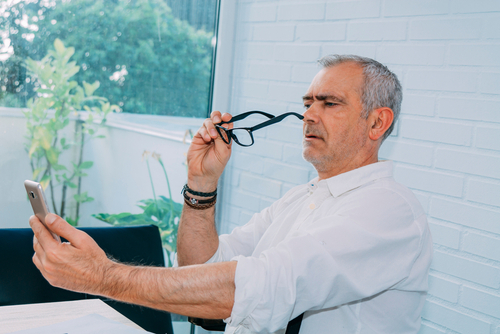
Do you need to use reading glasses to see things with tiny print, like the newspaper? You’re not alone.
Many people over the age of 40 struggle with presbyopia. Presbyopia is a condition that makes it harder to see up close.
Aging causes the natural lens inside the eye to lose flexibility. When this happens, it becomes much more challenging to focus.
Presbyopia is an almost inevitable part of aging, and the most obvious solution is using reading glasses. Reading glasses can help you see up close, but they have a limited design.
You can’t wear them all the time, as they distort your distance vision and your ability to see things far away. Luckily, reading glasses aren’t your only option for treating presbyopia.
One immensely popular alternative is a procedure called Refractive Lens Exchange (RLE). While RLE isn’t guaranteed to eliminate the need for reading glasses, it can dramatically reduce your dependence on them and improve your vision at all distances.
Keep reading to learn more about RLE and if it could be a way to say goodbye to readers for good!
What is Refractive Lens Exchange?
Refractive Lens Exchange is a surgical procedure that replaces the natural lens in your eye with an artificial one called an intraocular lens. You don’t need general anesthesia, meaning you can go home the same day.
Before RLE begins, you’ll receive numbing eye drops. Once these drops spread over the surface of your eye, your surgeon will start by creating a small incision in your eye. This is often done with a laser to eliminate the use of a blade.
They will then break up your natural lens into smaller pieces and remove it through the incision. After removing the lens, you’ll have your new IOL inserted.
The IOL is gently unfurled before your surgeon positions it. With the IOL positioned, the procedure is complete. The incision is small enough that it doesn’t require any stitches.
Recovering after Refractive Lens Exchange is short; most patients immediately notice an improvement in their vision. Before you know it, you’ll be able to do the things you love without relying on reading glasses!
RLE vs. Cataract Surgery
If RLE sounds like it’s similar to another procedure, that’s because it’s almost identical to cataract surgery. The most significant difference between Refractive Lens Exchange and cataract surgery is that you have a cataract removed during cataract surgery. RLE is performed earlier in life before a cataract has formed in the natural lens of the eye.
During RLE and cataract surgery, the natural lens is removed and replaced with an intraocular lens. If you have cataracts, you’ll have cataract surgery instead of RLE. The result is the same, and you’ll still be able to improve your vision with IOLs.
One of the best things about having RLE is that you won’t have to worry about cataracts later. A cataract cannot form on an intraocular lens.
By removing the natural lens before cataracts have the opportunity to form or develop, you can look forward to clear vision for the rest of your life.
Intraocular Lenses
When you get RLE or cataract surgery, an integral part of the procedure is deciding what kind of IOL to have. Many varieties of IOLs are available, depending on your visual goals after correcting your vision.
Monofocal lenses are standard IOLs that are set to a single refractive power, typically for distance or reading. Some people who get monofocal IOLs opt for monovision. With monovision, you have one lens set for seeing up close in one eye, and the other lens is for seeing far away in your other eye.
Patients end up with adequate vision at most intermediate distances. However, patients who get monofocal lenses, even if they get monovision, often still need reading glasses to see well up close.
For patients that want to get the most out of RLE, it’s best to consider premium IOLs. With a premium IOL, you can reduce your dependence on reading glasses and improve your vision.
There are a lot of premium IOLs to choose from, depending on your visual correction needs. We offer our patients only the best and most state-of-the-art premium lenses at Diagnostic Eye Center. Here are the options you can choose from at our practice:
PanOptix Trifocal IOL
The PanOptix trifocal IOL is divided into three sections. One is for seeing up close, one set to see at a distance, and one set to see at an intermediate distance.
Having the PanOptix IOL trains your brain to look through the right part of the lens depending on what you’re seeing. The PanOptix trifocal lens gives you clear middle distance and close-up vision, making it ideal for anyone who uses a computer screen as you can view it clearly from a healthy distance.
Tecnis Symfony IOL
The Symfony IOL is an Extended Depth of Focus lens, offering clear vision from a distance up to about an arm’s length away. The Symfony lens can give you excellent vision at many distances, but some patients still need readers for fine-focus tasks, like reading small print.
Synergy IOL
The Synergy IOL is one of the newest IOLs on the market. It offers the broadest range of vision of any IOL currently available and helps you see better in low-light settings.
Vivity IOL
The Vivity IOL is the only non-diffractive extended depth of focus lens. The lens allows you to see at multiple distances. Its surface transitions between different refractive powers.
The Vivity IOL is non-diffractive because the division between these sections is blended, so light doesn’t split over the lens. This allows the lenses to give you a wide range of vision with fewer visual aberrations.
Toric
Toric lenses are the only IOLs specifically designed to correct astigmatism. If you have mild astigmatism as well as presbyopia, a toric lens can correct both at the same time.
You may find it hard to choose the perfect IOL with so many options. The good news is that it’s hard to go wrong with your decision as all these options have many benefits and can reduce your dependency on reading glasses.
During your consultation, our doctors will perform several scans of your eyes and discuss which options would be best for the health of your eyes and your specific visual needs.
Are you interested in the freedom that Refractive Lens Exchange can give you? Schedule a consultation at Diagnostic Eye Center in Houston, TX, to learn more!

